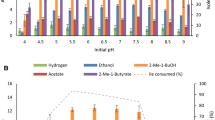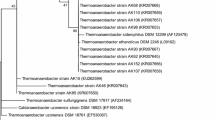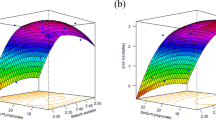Abstract
The fermentation of branched-chain amino acids (BCAAs) to branched-chain fatty acids (BCFAs) and branched-chain alcohols (BCOHs) is described using Thermoanaerobacter pseudoethanolicus. BCAAs were not degraded without an electron scavenging system but were degraded to a mixture of their BCFA (major) and BCOH (minor) when thiosulfate was added to the culture. Various environmental parameters were investigated using isoleucine as the substrate which ultimately demonstrated that at higher liquid–gas phase ratios the formation of 2-methyl-1-butanol from isoleucine achieved a maximal titer of 3.4 mM at a 1:1 liquid–gas ratio suggesting that higher partial pressure of hydrogen influences the BCOH/BCFA ratio but did not increase further with higher L–G phase ratios. Alternately, increasing the thiosulfate concentration decreased the BCOH to BCFA ratio. Kinetic monitoring of BCAA degradation revealed that the formation of BCOHs occurs slowly after the onset of BCFA formation. 13C2-labeled studies of leucine confirmed the production of a mixture of 3-methyl-1-butyrate and 3-methyl-1-butanol, while experiments involving 13C1-labeled 3-methyl-1-butyrate in fermentations containing leucine demonstrated that the carboxylic acid is reduced to the corresponding alcohol. Thus, the role of carboxylic acid reduction is likely of importance in the production of BCOH formation during the degradation of BCAA such as leucine.







Similar content being viewed by others
References
Andreesen JR, Bahl H, Gottschalk G (1989) Introduction to the physiology and biochemistry of the genus Clostridium. In: Minton NP, Clarke DJ (eds) Clostridia. Plenum Press, New York, pp 27–62
Barker HA (1939) The use of glutamic acid for the isolation and identification of Clostridium cochlearium and Cl. tetanomorphum. Arch Microbiol 10:376–389
Bradford MM (1976) A rapid and sensitive method for the quantitation of microgram quantities of protein utilizing the principle of protein-dye binding. Anal Biochem 72:248–254
Bryant FO, Wiegel J, Ljungdahl LG (1988) Purification and properties of primary and secondary alcohol dehydrogenases from Thermoanaerobacter ethanolicus. Appl Environ Microbiol 54:460–465
Bsharat O, Musa MM, Vieille C et al (2017) Asymmetric reduction of substituted 2-tetralones by Thermoanaerobacter pseudoethanolicus secondary alcohol dehydrogenase. ChemCatChem 9:1487–1493. https://doi.org/10.1002/cctc.201601618
Burdette D, Zeikus JG (1994) Purification of acetaldehyde dehydrogenase and alcohol dehydrogenases from Thermoanaerobacter ethanolicus 39E and characterization of the secondary-alcohol dehydrogenase (2° Adh) as a bifunctional alcohol dehydrogenase-acetyl-CoA reductive thioes. Biochem J 302:163–170
Burdette DS, Jung S-H, Shen G-J et al (2002) Physiological function of alcohol dehydrogenases and long-chain (C30) fatty acids in alcohol tolerance of Thermoanaerobacter ethanolicus. Appl Environ Microbiol 68:1914–1918. https://doi.org/10.1128/AEM.68.4.1914-1918.2002
Chades T, Scully SM, Ingvadottir EM, Orlygsson J (2018) Fermentation of mannitol extracts from brown macro algae by thermophilic clostridia. Front Microbiol 9:1–13. https://doi.org/10.3389/fmicb.2018.01931
Cline JD (1969) Spectrophotometric determination of hydrogen sulfide in natural waters. Limnol Oceanogr 14:454–458
Elsden SR, Hilton MG (1978) Volatile acid production from threonine, valine, leucine and isoleucine by clostridia. Arch Microbiol 117:165–172. https://doi.org/10.1007/BF00402304
Elsden SR, Hilton MG (1979) Amino acid utalization patterns in clostridial taxonomy. Arch Microbiol 123:137–141
Eschenlauer SCP, Mckain N, Walker ND et al (2002) Ammonia production by ruminal microorganisms and enumeration, isolation, and characterization of bacteria capable of growth on peptides and amino acids from the sheep rumen. Appl Environ Microbiol 68:4925–4931. https://doi.org/10.1128/AEM.68.10.4925
Fardeau ML, Patel BKC, Magot M, Ollivier B (1997) Utilization of serine, leucine, isoleucine, and valine by Thermoanaerobacter brockii in the presence of thiosulfate or Methanobacterium sp. as electron accepters. Anaerobe 3:405–410. https://doi.org/10.1006/anae.1997.0126
Faudon C, Fardeau ML, Heim J et al (1995) Peptide and amino acid oxidation in the presence of thiosulfate by members of the genus Thermoanaerobacter. Curr Microbiol 31:152–157
Firkins JL, Yu Z, Morrison M (2007) Ruminal nitrogen metabolism: perspectives for integration of microbiology and nutrition for dairy. J Dairy Sci 90:E1–E16. https://doi.org/10.3168/jds.2006-518
Fonknechten N, Chaussonnerie S, Tricot S et al (2010) Clostridium sticklandii, a specialist in amino acid degradation: revisiting its metabolism through its genome sequence. BMC Genom 11:555. https://doi.org/10.1186/1471-2164-11-555
Gottschalk G (1986) Bacterial metabolism, 2nd edn. Springer, New York
Harwood CS, Canale-Parola E (1981) Branched-chain amino acid fermentation by a marine spirochete: strategy for starvation survival. J Bacteriol 148:109–116
Harwood CS, Canale-Parola E (1983) Spirochaeta isovalerica sp. nov., a marine anaerobe that forms branched-chain fatty acids as fermentation products. Int J Syst Bacteriol 33:573–579
Hazelwood LA, Daran J-M, van Maris AJA et al (2008) The Ehrlich pathway for fusel alcohol production: a century of research on Saccharomyces cerevisiae metabolism. Appl Environ Microbiol 74:2259–2266. https://doi.org/10.1128/AEM.02625-07
He Q, Lokken PM, Chen S, Zhou J (2009) Characterization of the impact of acetate and lactate on ethanolic fermentation by Thermoanaerobacter ethanolicus. Bioresour Technol 100:5955–5965. https://doi.org/10.1016/j.biortech.2009.06.084
Hitschler L, Kuntz M, Langschied F, Basen M (2018) Thermoanaerobacter species differ in their potential to reduce organic acids to their corresponding alcohols. Appl Microbiol Biotechnol 102:8465–8476. https://doi.org/10.1007/s00253-018-9210-3
Kozianowski G, Canganella F, Rainey FA et al (1997) Purification and characterization of thermostable pectate-lyases from a newly isolated thermophilic bacterium, Thermoanaerobacter italicus sp. nov. Extremophiles 1:171–182. https://doi.org/10.1007/s007920050031
Lamed RJ, Zeikus JG (1981) Novel NADP-linked alcohol-aldehyde/ketone oxidoreductase in thermophilic ethanologenic bacteria. Biochem J 195:183–190
Lee C, Saha BC, Zeikus JG (1990) Characterization of Thermoanaerobacter glucose isomerase in relation to saccharidase synthesis and development of single-step processes for sweetener production. Appl Environ Microbiol 56:2895–2901
Leyer GJ, Johnson EA (1990) Repression of toxin production by tryptophan. Arch Microbiol 154:443–447
Loll MJ, Bollag J-M (1983) Protein transformation in soil. Adv Agron 36:351–382
McInerney MJ (1988) Anaerobic hydrolysis and fermentation of fats and proteins. In: Zehnder AJB (ed) Biology of anaerobic microorganisms. Wiley, New York, pp 373–415
Mead GC (1971) The amino acid-fermenting clostridia. J Gen Microbiol 67:47–56. https://doi.org/10.1099/00221287-67-1-47
Mitchell WJ (2001) Biology and physiololgy. In: Bahl H, Durre P (eds) Clostridia: biotechnology and medical applications. Wiley-VCH, Weinheim, pp 49–104
Mitruka BM, Costilow RN (1967) Arginine and ornithine catabolism by Clostridium botulinum. J Bacteriol 93:295–301
Musa MM, Phillips RS (2011) Recent advances in alcohol dehydrogenase-catalyzed asymmetric production of hydrophobic alcohols. Catal Sci Technol 1:1311–1323. https://doi.org/10.1039/c1cy00160d
Musa MM, Bsharat O, Karume I et al (2018) Expanding the substrate specificity of Thermoanaerobacter pseudoethanolicus secondary alcohol dehydrogenase by a dual site mutation. Eur J Org Chem 2018:798–805. https://doi.org/10.1002/ejoc.201701351
Napora-Wijata K, Strohmeier GA, Winkler M (2014) Biocatalytic reduction of carboxylic acids. Biotechnol J 9:822–843. https://doi.org/10.1002/biot.201400012
Onyenwoke RU, Kevbrin VV, Lysenko AM, Wiegel J (2007) Thermoanaerobacter pseudethanolicus sp. nov., a thermophilic heterotrophic anaerobe from Yellowstone National Park. Int J Syst Evol Microbiol 57:2191–2193. https://doi.org/10.1099/ijs.0.65051-0
Orlygsson J, Baldursson SRB (2007) Phylogenetic and physiological studies of four hydrogen-producing thermoanareobes. Iceland Agric Sci 20:93–105
Orlygsson J, Houwen FP, Svensson BH (1995) Thermophilic anaerobic amino acid degradation: deamination rates and end product formation. Appl Microbiol Biotechnol 43:235–241
Reid SJ, Stutz HE (2005) Nitrogen assimilation in clostridia. In: Durre P (ed) Handbook of clostridia. CRC Press, Boca Raton, pp 239–260
Schwartz AC, Schäfer R (1973) New amino acids, and heterocyclic compounds participating in the stickland reaction of Clostridium sticklandii. Arch Microbiol 276:267–276
Scully SM (2019) Amino acid and related catabolism of Thermoanaerobacter species. University of Iceland, Reykjavík
Scully SM, Orlygsson J (2014) Branched-chain alcohol formation from branched-chain amino acids by Thermoanaerobacter brockii and Thermoanaerobacter yonseiensis. Anaerobe 30:82–84. https://doi.org/10.1016/j.anaerobe.2014.09.003
Scully SM, Orlygsson J (2015) Amino acid metabolism of Thermoanaerobacter strain AK90: the role of electron-scavenging systems in end product formation. J Amino Acids. https://doi.org/10.1155/2015/410492
Scully SM, Orlygsson J (2019) Branched-chain amino acid catabolism of Thermoanaerobacter strain AK85 and the influence of culture conditions on branched-chain alcohol formation. Amino Acids. https://doi.org/10.1007/s00726-019-02744-z
Scully SM, Iloranta P, Myllymaki P, Orlygsson J (2015) Branched-chain alcohol formation by thermophilic bacteria within the genera of Thermoanaerobacter and Caldanaerobacter. Extremophiles 19:809–818. https://doi.org/10.1007/s00792-015-0756-z
Scully SM, Brown A, Ross AB, Orlygsson J (2019) Biotransformation of organic acids to their corresponding alcohols by Thermoanaerobacter pseudoethanolicus. Anaerobe 57:28–31. https://doi.org/10.1016/j.anaerobe.2019.03.004
Speelmans G, de Vrij W, Konings WN (1989) Characterization of amino acid transport in membrane vesicles from the thermophilic fermentative bacterium Clostridium fervidus. J Bacteriol 171:3788–3795
Stickland LH (1934) CCXXXII. Studies in the metabolism of the strict anaerobes (genus Clostridium). I. The chemical reactions by which Cl. sporogenes obtains its energy. Biochem J 28:1746–1759. https://doi.org/10.1042/bj0281746
Strobl G, Feicht R, White H et al (2011) The tungsten-containing aldehyde oxidoreductase from Clostridium thermoaceticum and its complex with a viologen-accepting NADPH oxidoreductase. Biol Chem Hoppe Seyler 373:123–132. https://doi.org/10.1515/bchm3.1992.373.1.123
Tarlera S, Muxí L, Soubes M, Stams AJ (1997) Caloramator proteoclasticus sp. nov., a new moderately thermophilic anaerobic proteolytic bacterium. Int J Syst Bacteriol 47:651–656
Westley J (1987) Thiocyanate and thiosulfate. Methods Enzymol 143:22–25
White H, Huber C, Feicht R, Simon H (1993) On a reversible molybdenum-containing aldehyde oxidoreductase from Clostridium formicoaceticum. Arch Microbiol 159:244–249. https://doi.org/10.1007/BF00248479
Xue Y, Xu Y, Liu Y et al (2001) Thermoanaerobacter tengcongensis sp. nov., a novel anaerobic, saccharolytic, thermophilic bacterium isolated from a hot spring in Tengcong, China. Int J Syst Evol Microbiol 51:1335–1341. https://doi.org/10.1099/00207713-51-4-1335
Yao S, Mikkelsen MJ (2010) Identification and overexpression of a bifunctional aldehyde/alcohol dehydrogenase responsible for ethanol production in Thermoanaerobacter mathranii. J Mol Microbiol Biotechnol 19:123–133. https://doi.org/10.1159/000321498
Zeikus JG, Ben-Bassat A, Hegge PW (1980) Microbiology of methanogenesis in thermal, volcanic environments. J Bacteriol 143:432–440
Zhou J, Shao X, Olson DG et al (2017) Determining the roles of the three alcohol dehydrogenases (AdhA, AdhB and AdhE) in Thermoanaerobacter ethanolicus during ethanol formation. J Ind Microbiol Biotechnol 44:745–757. https://doi.org/10.1007/s10295-016-1896-6
Acknowledgements
The authors are grateful for funding for this work from Landsvirkjun (NÝR-08 – 2015). The authors wish to thank Sigríður Jónsdóttir of the University of Iceland for her assistance with obtaining the NMR spectra and Eva María Ingvadóttir for her much appreciated editorial assistance.
Author information
Authors and Affiliations
Corresponding author
Ethics declarations
Conflict of interest
The authors declare that they have no conflicts of interest.
Additional information
Communicated by H. Atomi.
Publisher's Note
Springer Nature remains neutral with regard to jurisdictional claims in published maps and institutional affiliations.
Electronic supplementary material
Below is the link to the electronic supplementary material.
Rights and permissions
About this article
Cite this article
Scully, S.M., Orlygsson, J. Branched-chain amino acid catabolism of Thermoanaerobacter pseudoethanolicus reveals potential route to branched-chain alcohol formation. Extremophiles 24, 121–133 (2020). https://doi.org/10.1007/s00792-019-01140-5
Received:
Accepted:
Published:
Issue Date:
DOI: https://doi.org/10.1007/s00792-019-01140-5




